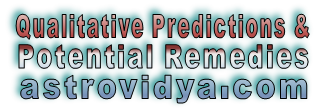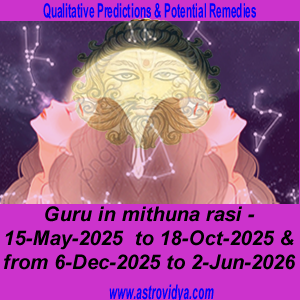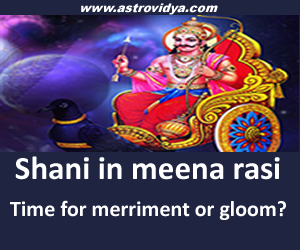


Open Sesame
Write-ups at a glance
Write-ups at a glance
Search by Google:


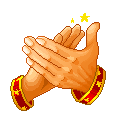
Disclaimer: All material on the site, www.astrovidya.com are for entertainment purposes only and no guarantee is implied as to the accuracy of contents or advertisements contained in or linked to this website. The contents are based on ancient cannons of astrology and should not be interpreted as legal, financial, political, religious, ethical, medical, psychological, psychiatric or any other specialist advice. The user is wholly responsible for his choices, decisions, judgments and risks. In no event shall the site be liable for any direct, indirect, incidental, punitive or consequential damages of any kind whatsoever with respect to its service, materials and products. By using the services you confirm that you are over 18 and that you understand and agree with these terms of Disclaimer. If you disagree with any part of these terms and conditions, please egress the website.
Pranayama is an integral part of yogabhyasa. pranayama means 'giving new direction to the life force'. because it rejuvenates all the nadis (nerve centers) and breathing apparatus. It is good to do some asanas before taking up pranayama. But some rest (by doing shavasana) is essential before beginning pranayama. In the course of pranayama some mudras (posture of hands) are used. The sitting posture should be veerasana or padmasana.
Pranayama should not be done more than 15-20 minute a day at a stretch. The stomach should be empty. The nasal channel should be clean and clear. In the beginning one should condition the respiratory organs. These exercises are called 'swasa sudharana'. These can be practiced for a month or so. Following are 'swasa sudharana' pranayama s.
Pranayama should not be done more than 15-20 minute a day at a stretch. The stomach should be empty. The nasal channel should be clean and clear. In the beginning one should condition the respiratory organs. These exercises are called 'swasa sudharana'. These can be practiced for a month or so. Following are 'swasa sudharana' pranayama s.
PRANAYAMA - METHODS & PRACTICE
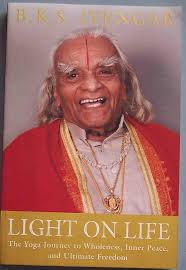
People with respiratory diseases, allergy, ear/nose discharge, migraine headache, cardiac problems or those suffering blood pressure, giddiness should never ever venture the following prayanayama s namely bhastrika, kapalabhati, wassa dhouthi and anunansika dhouthi.
The sitting posture for the next four varieties are: padmasana, swastikasna. The mudra is hasta mudra (holding nostrils with little and ring fingers while index and middle fingers are folded inside). Some people extend the index and middle fingers to rest on the forehead (prana mudra). We can do this way also provided the extended finger on the forehead do not shake. In these pranayama , there is no retention of breath. For swasa dhouthi pranayama veerasana is suitable.
Bhastrika: Fast single time forceful breathing in through right nostril and expelling rapidly 6-8 times through the same nostril. Fast single time forceful breathing in through left nostril and expelling rapidly 6-8 times through same nostril. Finally, same procedure is done with both nostrils for 6-8 times (repeated 3-5 times)
Kapala bhati: Expelling through right nostril rapidly 6-8 times; expelling through left nostril 6-8 times and finally through both nostrils 6-8 times and finally breathing in through both nostrils slowly (3-5 times)
Swasa dhouthi: Breathing out making lips like tube puffing off with force, bending forward. This process ends when forehead touches the ground. Should come back to original position slowly breathing in through both nostrils(3-5 times)
Anunasika dhouthi: Breathing in slowly through right nostril and breathing out through left in a single puff; breathing in through left nostril slowly and breathing out through right in a single puff. Finally, breathing in through both nostrils and puffing off at once.(3-5 times)
The next step is the conditioned slow breathing without any retention (kumbhaka rahita).
Nadi suddhi: Breathing in through left nostril and breathing out through right and breathing in through right and breathing out through left nostril (10-20 times)
Anuloma-viloma: slow breathing in both nostrils (10-20 times)
Suryanuloma: breathing slowly through right nostril (pingala) only10-20 times.
Chandranuloma: breathing through left nostril (ida) only 10-20 times.
The sitting posture for the next four varieties are: padmasana, swastikasna. The mudra is hasta mudra (holding nostrils with little and ring fingers while index and middle fingers are folded inside). Some people extend the index and middle fingers to rest on the forehead (prana mudra). We can do this way also provided the extended finger on the forehead do not shake. In these pranayama , there is no retention of breath. For swasa dhouthi pranayama veerasana is suitable.
Bhastrika: Fast single time forceful breathing in through right nostril and expelling rapidly 6-8 times through the same nostril. Fast single time forceful breathing in through left nostril and expelling rapidly 6-8 times through same nostril. Finally, same procedure is done with both nostrils for 6-8 times (repeated 3-5 times)
Kapala bhati: Expelling through right nostril rapidly 6-8 times; expelling through left nostril 6-8 times and finally through both nostrils 6-8 times and finally breathing in through both nostrils slowly (3-5 times)
Swasa dhouthi: Breathing out making lips like tube puffing off with force, bending forward. This process ends when forehead touches the ground. Should come back to original position slowly breathing in through both nostrils(3-5 times)
Anunasika dhouthi: Breathing in slowly through right nostril and breathing out through left in a single puff; breathing in through left nostril slowly and breathing out through right in a single puff. Finally, breathing in through both nostrils and puffing off at once.(3-5 times)
The next step is the conditioned slow breathing without any retention (kumbhaka rahita).
Nadi suddhi: Breathing in through left nostril and breathing out through right and breathing in through right and breathing out through left nostril (10-20 times)
Anuloma-viloma: slow breathing in both nostrils (10-20 times)
Suryanuloma: breathing slowly through right nostril (pingala) only10-20 times.
Chandranuloma: breathing through left nostril (ida) only 10-20 times.
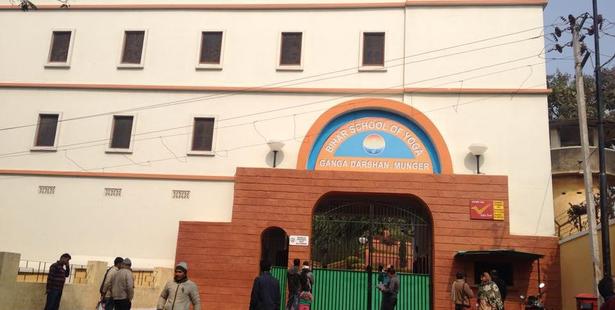
Udara swasa: Deep breathing in both nostrils with stomach movement. The sitting position is veerasana and jnana mudra (touching index finger to thumb holding other fingers straight).
Uru swasa: Deep breathing with middle chest movement. The sitting position be veerasana with chinmaya mudra (touching index finger to thumb but all other fingers are folded inside palm).
Greva swasa: Deep breathing with upper chest movement. The sitting position is veerasana with adi mudra (folding thumb inside palm and clasping all fingers over thumb).
Poorna swasa: Deep breathing involving stomach, middle chest and upper chest. Sitting position be veerasana with brahma mudra (both hands in adi mudra touching each other at fingers' side at he naval level).
One should not do brisk (fast or forced) breathing at all during above varieties. The complete process of breathing is done 5 minutes each slowly. The above four pranayama s are perfectly suited to asthmatic people as there is no kumbhaka (retention) or forced breathing. There is no need to close the nostrils with fingers.
After conditioning as above, we can dispense with these preliminary exercises (You do not 'copy write' in your graduate levels!).
Uru swasa: Deep breathing with middle chest movement. The sitting position be veerasana with chinmaya mudra (touching index finger to thumb but all other fingers are folded inside palm).
Greva swasa: Deep breathing with upper chest movement. The sitting position is veerasana with adi mudra (folding thumb inside palm and clasping all fingers over thumb).
Poorna swasa: Deep breathing involving stomach, middle chest and upper chest. Sitting position be veerasana with brahma mudra (both hands in adi mudra touching each other at fingers' side at he naval level).
One should not do brisk (fast or forced) breathing at all during above varieties. The complete process of breathing is done 5 minutes each slowly. The above four pranayama s are perfectly suited to asthmatic people as there is no kumbhaka (retention) or forced breathing. There is no need to close the nostrils with fingers.
After conditioning as above, we can dispense with these preliminary exercises (You do not 'copy write' in your graduate levels!).
Yogacharya Padmashri B. K. S. Iyengar

Padmasana
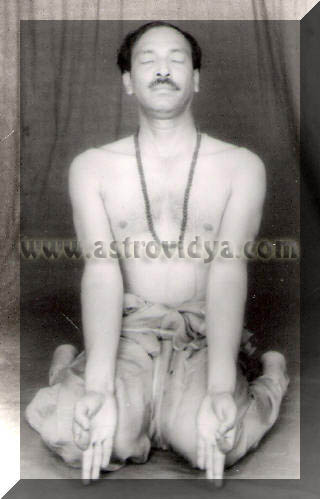
Veeraasana

Chinmaya mudra

Brahma mudra

Gnana mudra

Hasta mudra
Bihar School of Yoga, Munger founded by Swami Satyananda Saraswati in 1964, is reputed School of yoga
Chandarnuloma should not be done by people having sensitivity to cold diseases and low blood pressure. Suryoanuloma should not be done by people with hypertension, anxiety and mental disturbances. Even for fun's sake, both chandranuloma and suryanuloma SHOULD NOT be done on the same day. Other pranayama s like sheetali, sheetkari, sadanta SHOULD NOT be done with Chandranuloma and/or Suryanuloma.
For those who want a resounding clarity in voice (like teachers, vocal musicians, actors, and radio artists) Bramari pranayama is recommended, it promotes greater control on vocal chords.
Bramari: Breathing through both nostrils and holding for some 10 seconds (and NOT MORE THAN THAT) and slowing expelling making humming sound. There should be consistency in the humming sound. While breathing in, the neck should bend forward and touch chest at the culmination of in take and while breathing out the neck should be thrown backwards slowly (Jalandhara bandha). There is no stopping after breathing out (bahya kumbhaka). Sheetali, Sheetkari, Sadanta, Swana and Kaki are almost similar to douthi and chandranuloma in results and practice. And so, need not have to be practiced separately.
The more advanced varieties of pranayama like pancha sahita, ujjayi, surya bedhana, nadi sodhana, viloma, anuloma and pratiloma involve stopping of breathing after exhalation (bahya kumbhaka). These varieties may not be suitable to all. Further, people after 35 years of age (the end of health scale for most of us, unfortunately!) should practice the bahya kumbhaka period for the half duration of antara kumbhaka. As these varieties involve an element of risk, these should better be learnt personally from a qualified guru, to avoid any untoward effects.
For those who want a resounding clarity in voice (like teachers, vocal musicians, actors, and radio artists) Bramari pranayama is recommended, it promotes greater control on vocal chords.
Bramari: Breathing through both nostrils and holding for some 10 seconds (and NOT MORE THAN THAT) and slowing expelling making humming sound. There should be consistency in the humming sound. While breathing in, the neck should bend forward and touch chest at the culmination of in take and while breathing out the neck should be thrown backwards slowly (Jalandhara bandha). There is no stopping after breathing out (bahya kumbhaka). Sheetali, Sheetkari, Sadanta, Swana and Kaki are almost similar to douthi and chandranuloma in results and practice. And so, need not have to be practiced separately.
The more advanced varieties of pranayama like pancha sahita, ujjayi, surya bedhana, nadi sodhana, viloma, anuloma and pratiloma involve stopping of breathing after exhalation (bahya kumbhaka). These varieties may not be suitable to all. Further, people after 35 years of age (the end of health scale for most of us, unfortunately!) should practice the bahya kumbhaka period for the half duration of antara kumbhaka. As these varieties involve an element of risk, these should better be learnt personally from a qualified guru, to avoid any untoward effects.


